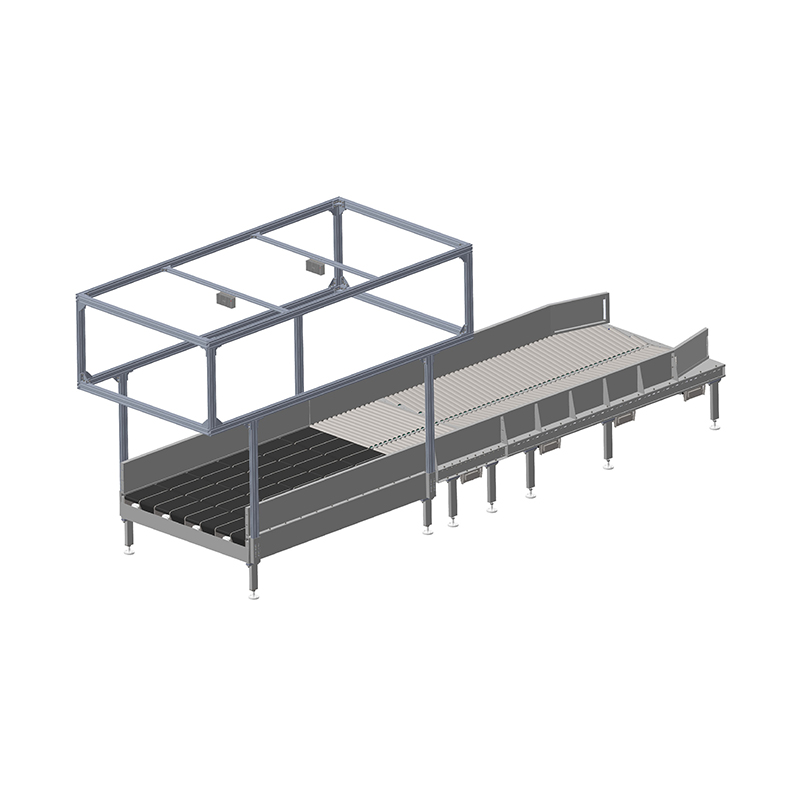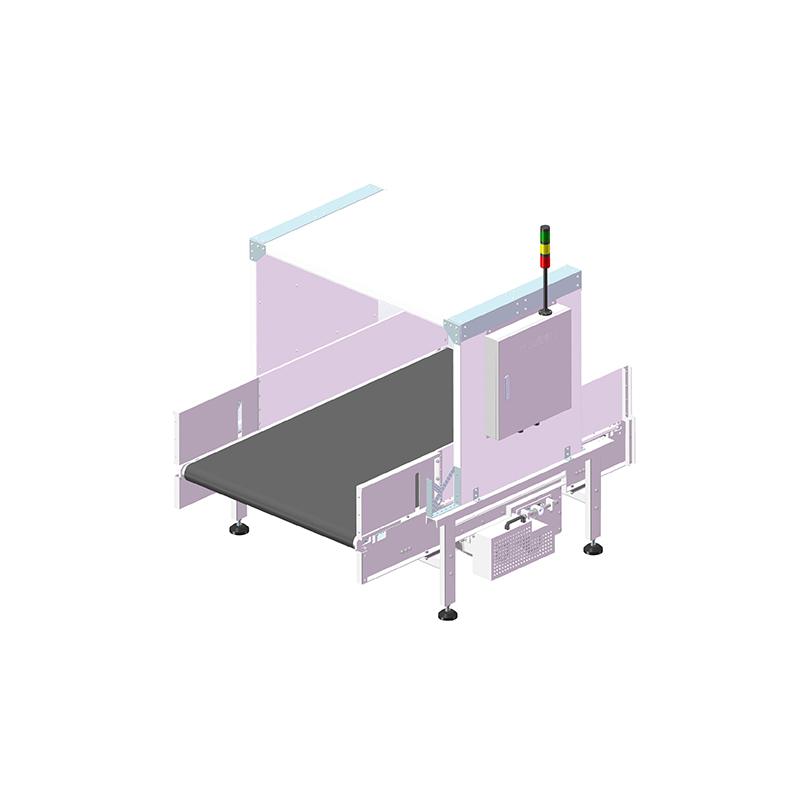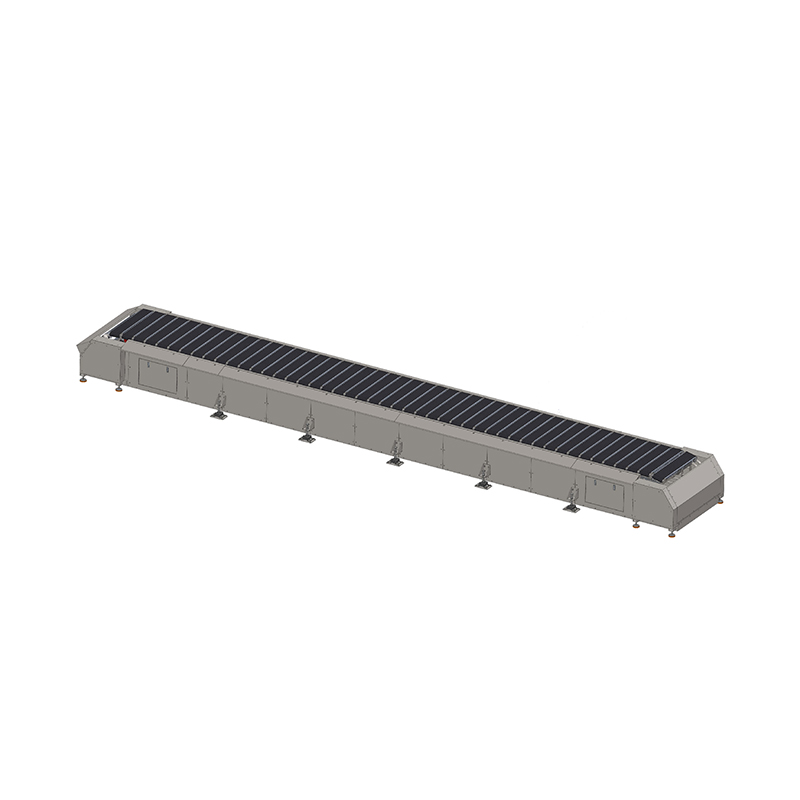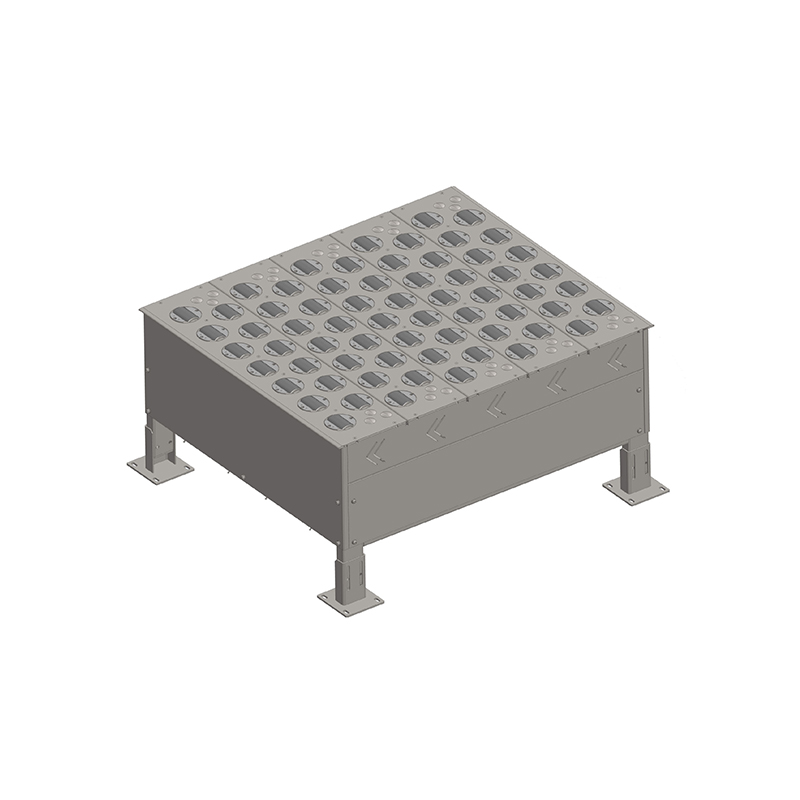2D bulk separator is a smart choice for logistics sorting
Release Time : 2025-03-11
Revealing the secret of 2D bulk separator: the secret of efficient sorting!
In modern logistics warehousing systems, how to efficiently and accurately handle a large number of packages has always been the focus of the industry. With the vigorous development of e-commerce, the volume of express delivery business has grown explosively, and the traditional manual sorting method has been difficult to meet the growing market demand. Against this background, the two-dimensional bulk single-piece separator came into being. It brought a revolution to the logistics industry and became a key equipment for improving sorting efficiency and accuracy.
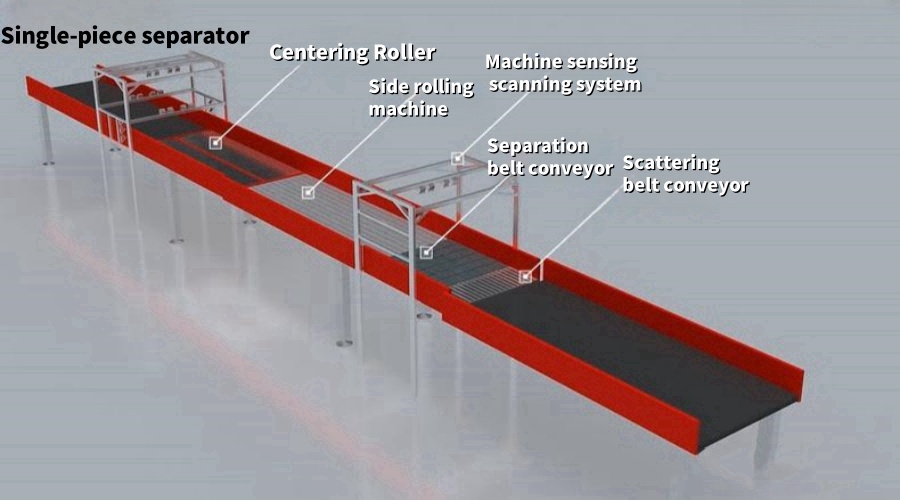
1. Working principle and composition of two-dimensional bulk single-piece separator
The two-dimensional bulk single-piece separator is mainly composed of a scattering belt conveyor, a separation belt conveyor and a visual recognition system. When batch packages enter the device, the scattering belt conveyor plays a role first. It will initially disperse the mixed packages, so that the originally messy packages are distributed relatively evenly, creating good conditions for subsequent separation operations. This process is like a group of people who were originally tightly gathered, and began to spread out to the surroundings through some force, each with a certain distance.
Then, the separation belt conveyor further separates and pulls the packages. It will separate the packages one by one according to the preset rules and rhythm, ensuring that each package maintains a suitable distance, just like soldiers in a queue, keeping a neat spacing waiting to move forward. The visual recognition system is like the "eyes" of the device, which can accurately identify the characteristics of each package, such as shape, size, barcode, etc. With this information, the device can classify and sort the packages and guide them to the next link along the specified path. This intelligent recognition and sorting function makes the entire sorting process more orderly and efficient, greatly reducing the possibility of parcel sorting errors.
2. Application scenarios of two-dimensional bulk single-piece separator
1. Express sorting center
In the express sorting center, tens of thousands of packages need to be processed every day. These packages come from different regions, different senders and recipients, and are of various types and specifications. The two-dimensional bulk single-piece separator is very useful here. It can quickly separate a large number of packages one by one, whether it is small letters, documents, or large home appliances and furniture packaging boxes, they can be separated accurately. Then, by seamlessly connecting with the subsequent automated sorting line, the parcels are classified and sorted according to different destinations and express delivery routes. For example, parcels sent to the northern region will be sorted into corresponding areas and prepared to be loaded and transported to various outlets in the north. In this way, the originally complex and cumbersome sorting work becomes orderly, greatly improving the efficiency of express sorting and shortening the time from parcel delivery to delivery.

2. E-commerce warehouse
The development of the e-commerce industry has led to a huge cargo throughput in e-commerce warehouses. In e-commerce warehouses, goods need to circulate in multiple links such as receiving, storing, picking, and shipping. The two-dimensional bulk single-piece separator plays an important role in the picking link. When the order is generated, the warehouse management system will issue an instruction, and the two-dimensional bulk single-piece separator will start working to accurately separate the goods in the storage area and combine and package them according to the order requirements. Its high-precision recognition system can ensure that the picked goods are correct, avoiding problems such as wrong delivery and missing delivery due to human errors. Moreover, its efficient separation speed can meet the needs of e-commerce for fast delivery, and even during peak shopping periods, it can ensure timely delivery of goods and improve customer satisfaction.
3. Collaboration with other related systems
1. Collaboration with the warehouse management system (WMS)
The warehouse management system (WMS) is an important software system for managing warehouses and logistics operations. The two-dimensional bulk single-piece separator works closely with the WMS. When a package enters the warehouse, the WMS will record the relevant information of the package, such as the time of entry, source, quantity, etc. This information will be transmitted to the two-dimensional bulk single-piece separator in real time, and the equipment will perform targeted separation operations on the package based on this information. At the same time, the package information obtained by the two-dimensional bulk single-piece separator during the separation process, such as weight, size, actual quantity, etc., will also be fed back to the WMS. WMS updates the inventory data based on this feedback information to achieve accurate management of warehouse goods. For example, if the actual weight of a separated package does not match the system record, the WMS can issue an alarm in time to remind the staff to check, which may be due to problems with the package during transportation.

2. Collaboration with the distribution center
As a logistics base integrating multiple functions such as processing, sorting, and delivery, the distribution center plays a key role in connecting the upper and lower levels in the logistics distribution network. The two-dimensional bulk single-piece separator provides strong support for the efficient operation of the distribution center. A large number of parcels gathered from various places to the distribution center are first pre-processed by the two-dimensional bulk single-piece separator, and the parcels are preliminarily classified according to different directions and destinations. In this way, when the parcels enter the distribution center, the staff can make more detailed sorting and distribution arrangements based on the already classified parcels. For example, for parcels in the same area, centralized loading and distribution can be carried out, which improves distribution efficiency and reduces logistics costs.
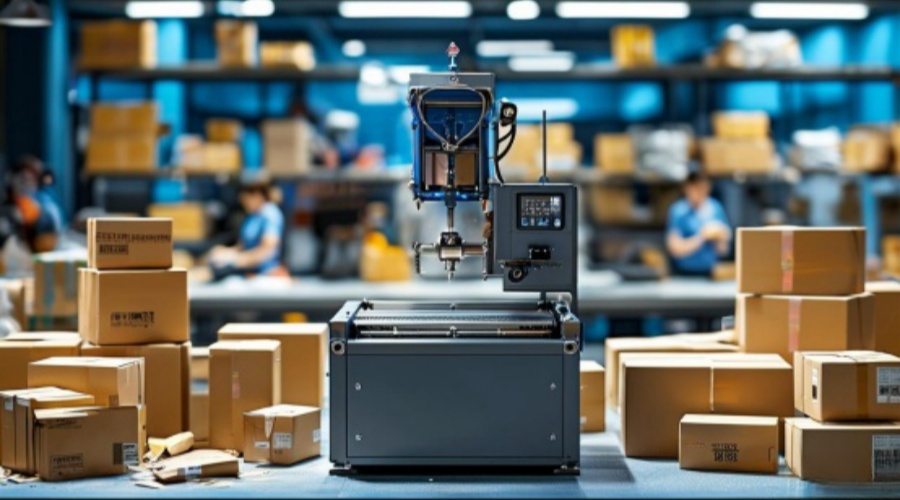
4. Advantages and value of two-dimensional bulk single-piece separator
1. Improve sorting efficiency
As mentioned above, the two-dimensional bulk single-piece separator can process up to 4,000, 6,000 or even 10,000 parcels per hour. Compared with traditional manual sorting or simple mechanical sorting, this is undoubtedly a huge leap. In high-intensity operating environments such as express sorting centers and e-commerce warehouses, this efficient sorting efficiency means that more parcels can be processed in the same time to meet the growing business needs. Take a large e-commerce warehouse as an example. During promotional activities, the daily order volume may reach hundreds of thousands. Without an efficient two-dimensional bulk cargo separator, manual sorting alone would not only require the employment of a large number of workers, but would also be difficult to complete the sorting task in a short period of time, which may lead to a backlog of goods and delay the delivery time. With a two-dimensional bulk cargo separator, it can separate a large number of packages in a short period of time, saving valuable time for subsequent packaging and delivery.
2. Ensure sorting accuracy
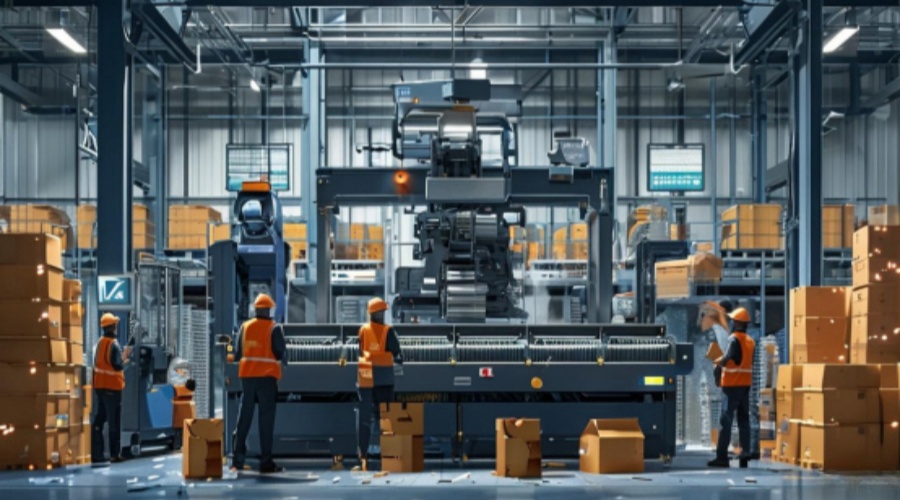
The application of the visual recognition system enables the two-dimensional bulk cargo separator to accurately identify the characteristics of each package. By accurately identifying the shape, size, barcode and other information of the package, the equipment can accurately separate the package into the corresponding category. This high degree of accuracy helps reduce sorting errors and improve the delivery success rate of the package. For consumers, they can receive the goods they purchased faster; for logistics companies, it can reduce customer complaints and compensation caused by sorting errors, and enhance the company's reputation and competitiveness.
5. Development Trends and Challenges
With the continuous advancement of science and technology, the two-dimensional bulk cargo separator is also constantly developing and improving. In the future, it may be combined with more advanced technologies such as artificial intelligence and the Internet of Things. Through deep learning algorithms, the equipment's recognition ability will be stronger and it will be able to handle more complex and diverse package types. For example, for some packages with irregular shapes and special materials, the equipment can also accurately identify and separate them. In addition, the integration of IoT technology can realize remote monitoring and management of equipment, timely detect equipment failures and repair them, and further improve the operating efficiency and reliability of equipment.
In the process of development, there are also some challenges. On the one hand, with the globalization and diversification of logistics business, the types and specifications of packages are becoming more and more complex, and the requirements for two-dimensional bulk single-piece separators are becoming higher and higher. Equipment needs to be continuously upgraded and improved to adapt to the parcel standards of different countries and regions and new logistics business needs. On the other hand, technological innovation also requires a lot of capital and manpower. The development of more advanced identification systems and more efficient separation mechanisms requires companies to have strong technical strength and financial support. But overall, the two-dimensional bulk single-piece separator has broad development prospects in the logistics industry. It will continue to improve its performance and value with the continuous advancement of technology, and make greater contributions to the efficient operation of logistics warehousing systems.

In modern logistics warehousing systems, how to efficiently and accurately handle a large number of packages has always been the focus of the industry. With the vigorous development of e-commerce, the volume of express delivery business has grown explosively, and the traditional manual sorting method has been difficult to meet the growing market demand. Against this background, the two-dimensional bulk single-piece separator came into being. It brought a revolution to the logistics industry and became a key equipment for improving sorting efficiency and accuracy.

1. Working principle and composition of two-dimensional bulk single-piece separator
The two-dimensional bulk single-piece separator is mainly composed of a scattering belt conveyor, a separation belt conveyor and a visual recognition system. When batch packages enter the device, the scattering belt conveyor plays a role first. It will initially disperse the mixed packages, so that the originally messy packages are distributed relatively evenly, creating good conditions for subsequent separation operations. This process is like a group of people who were originally tightly gathered, and began to spread out to the surroundings through some force, each with a certain distance.
Then, the separation belt conveyor further separates and pulls the packages. It will separate the packages one by one according to the preset rules and rhythm, ensuring that each package maintains a suitable distance, just like soldiers in a queue, keeping a neat spacing waiting to move forward. The visual recognition system is like the "eyes" of the device, which can accurately identify the characteristics of each package, such as shape, size, barcode, etc. With this information, the device can classify and sort the packages and guide them to the next link along the specified path. This intelligent recognition and sorting function makes the entire sorting process more orderly and efficient, greatly reducing the possibility of parcel sorting errors.
2. Application scenarios of two-dimensional bulk single-piece separator
1. Express sorting center
In the express sorting center, tens of thousands of packages need to be processed every day. These packages come from different regions, different senders and recipients, and are of various types and specifications. The two-dimensional bulk single-piece separator is very useful here. It can quickly separate a large number of packages one by one, whether it is small letters, documents, or large home appliances and furniture packaging boxes, they can be separated accurately. Then, by seamlessly connecting with the subsequent automated sorting line, the parcels are classified and sorted according to different destinations and express delivery routes. For example, parcels sent to the northern region will be sorted into corresponding areas and prepared to be loaded and transported to various outlets in the north. In this way, the originally complex and cumbersome sorting work becomes orderly, greatly improving the efficiency of express sorting and shortening the time from parcel delivery to delivery.

2. E-commerce warehouse
The development of the e-commerce industry has led to a huge cargo throughput in e-commerce warehouses. In e-commerce warehouses, goods need to circulate in multiple links such as receiving, storing, picking, and shipping. The two-dimensional bulk single-piece separator plays an important role in the picking link. When the order is generated, the warehouse management system will issue an instruction, and the two-dimensional bulk single-piece separator will start working to accurately separate the goods in the storage area and combine and package them according to the order requirements. Its high-precision recognition system can ensure that the picked goods are correct, avoiding problems such as wrong delivery and missing delivery due to human errors. Moreover, its efficient separation speed can meet the needs of e-commerce for fast delivery, and even during peak shopping periods, it can ensure timely delivery of goods and improve customer satisfaction.
3. Collaboration with other related systems
1. Collaboration with the warehouse management system (WMS)
The warehouse management system (WMS) is an important software system for managing warehouses and logistics operations. The two-dimensional bulk single-piece separator works closely with the WMS. When a package enters the warehouse, the WMS will record the relevant information of the package, such as the time of entry, source, quantity, etc. This information will be transmitted to the two-dimensional bulk single-piece separator in real time, and the equipment will perform targeted separation operations on the package based on this information. At the same time, the package information obtained by the two-dimensional bulk single-piece separator during the separation process, such as weight, size, actual quantity, etc., will also be fed back to the WMS. WMS updates the inventory data based on this feedback information to achieve accurate management of warehouse goods. For example, if the actual weight of a separated package does not match the system record, the WMS can issue an alarm in time to remind the staff to check, which may be due to problems with the package during transportation.

2. Collaboration with the distribution center
As a logistics base integrating multiple functions such as processing, sorting, and delivery, the distribution center plays a key role in connecting the upper and lower levels in the logistics distribution network. The two-dimensional bulk single-piece separator provides strong support for the efficient operation of the distribution center. A large number of parcels gathered from various places to the distribution center are first pre-processed by the two-dimensional bulk single-piece separator, and the parcels are preliminarily classified according to different directions and destinations. In this way, when the parcels enter the distribution center, the staff can make more detailed sorting and distribution arrangements based on the already classified parcels. For example, for parcels in the same area, centralized loading and distribution can be carried out, which improves distribution efficiency and reduces logistics costs.

4. Advantages and value of two-dimensional bulk single-piece separator
1. Improve sorting efficiency
As mentioned above, the two-dimensional bulk single-piece separator can process up to 4,000, 6,000 or even 10,000 parcels per hour. Compared with traditional manual sorting or simple mechanical sorting, this is undoubtedly a huge leap. In high-intensity operating environments such as express sorting centers and e-commerce warehouses, this efficient sorting efficiency means that more parcels can be processed in the same time to meet the growing business needs. Take a large e-commerce warehouse as an example. During promotional activities, the daily order volume may reach hundreds of thousands. Without an efficient two-dimensional bulk cargo separator, manual sorting alone would not only require the employment of a large number of workers, but would also be difficult to complete the sorting task in a short period of time, which may lead to a backlog of goods and delay the delivery time. With a two-dimensional bulk cargo separator, it can separate a large number of packages in a short period of time, saving valuable time for subsequent packaging and delivery.
2. Ensure sorting accuracy

The application of the visual recognition system enables the two-dimensional bulk cargo separator to accurately identify the characteristics of each package. By accurately identifying the shape, size, barcode and other information of the package, the equipment can accurately separate the package into the corresponding category. This high degree of accuracy helps reduce sorting errors and improve the delivery success rate of the package. For consumers, they can receive the goods they purchased faster; for logistics companies, it can reduce customer complaints and compensation caused by sorting errors, and enhance the company's reputation and competitiveness.
5. Development Trends and Challenges
With the continuous advancement of science and technology, the two-dimensional bulk cargo separator is also constantly developing and improving. In the future, it may be combined with more advanced technologies such as artificial intelligence and the Internet of Things. Through deep learning algorithms, the equipment's recognition ability will be stronger and it will be able to handle more complex and diverse package types. For example, for some packages with irregular shapes and special materials, the equipment can also accurately identify and separate them. In addition, the integration of IoT technology can realize remote monitoring and management of equipment, timely detect equipment failures and repair them, and further improve the operating efficiency and reliability of equipment.
In the process of development, there are also some challenges. On the one hand, with the globalization and diversification of logistics business, the types and specifications of packages are becoming more and more complex, and the requirements for two-dimensional bulk single-piece separators are becoming higher and higher. Equipment needs to be continuously upgraded and improved to adapt to the parcel standards of different countries and regions and new logistics business needs. On the other hand, technological innovation also requires a lot of capital and manpower. The development of more advanced identification systems and more efficient separation mechanisms requires companies to have strong technical strength and financial support. But overall, the two-dimensional bulk single-piece separator has broad development prospects in the logistics industry. It will continue to improve its performance and value with the continuous advancement of technology, and make greater contributions to the efficient operation of logistics warehousing systems.



